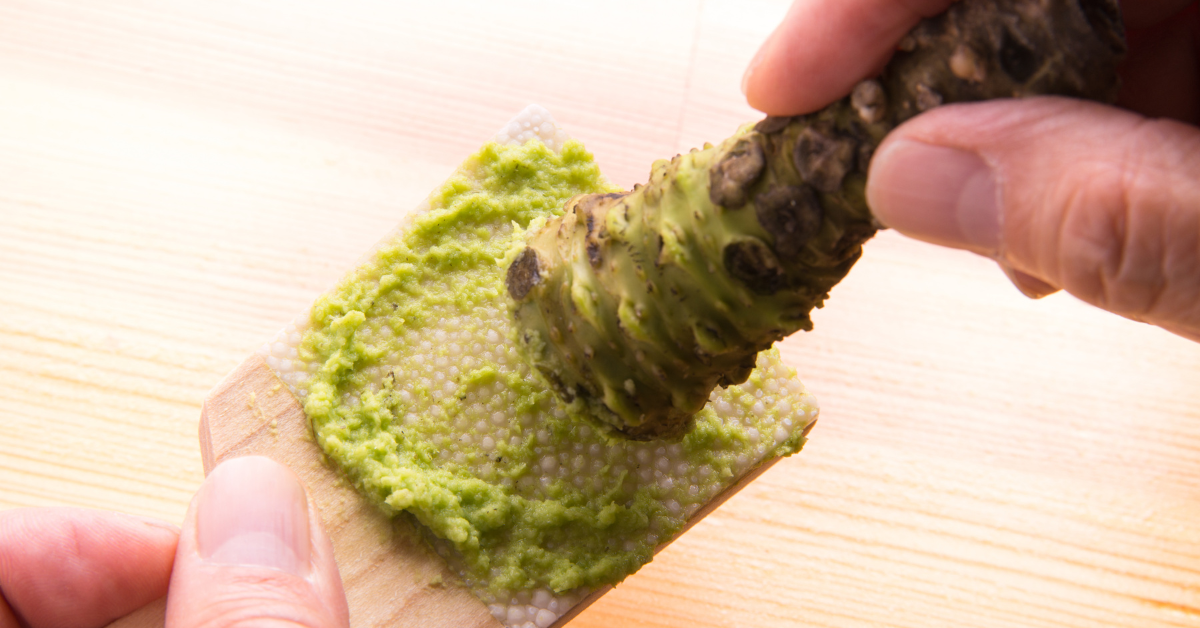Wasabi is more than just a spicy condiment—it represents Japan’s refined culinary spirit. Used in sushi, soba, and other iconic dishes, wasabi enhances flavor while symbolizing purity and balance. This article explains wasabi’s origins, uses, and cultural role in Japanese cuisine for international readers.
What Is Wasabi? Basic Information
Botanical Features of Wasabi
Wasabi is a perennial plant that grows in Japan’s cool, freshwater mountain streams. The rhizome is grated to create a paste with a distinctive pungent aroma. The sharp, sinus-clearing sensation comes from a compound called allyl isothiocyanate, which is released when the plant’s cells are crushed.
In addition, wasabi has antibacterial properties, making it an ideal complement to raw fish in preventing food poisoning.
Differences Between Real Wasabi and Western Wasabi
| Category | Real Wasabi | Western Wasabi (Horseradish) |
|---|---|---|
| Scientific Name | Wasabia japonica | Armoracia rusticana |
| Flavor Profile | Refined and aromatic pungency | Strong and coarse pungency |
| Color | Naturally light green | White (often dyed green artificially) |
| Common Uses | Sushi, soba, kaiseki cuisine | Commercial wasabi tubes, Western dishes |
| Availability | Expensive, limited availability | Affordable, widely distributed |
As seen above, they may share the name but differ entirely in nature. Experiencing authentic wasabi’s aroma and taste is a key to truly understanding Japanese cuisine.
How Wasabi Is Used in Cooking
Why It’s Essential for Sushi
The role of wasabi in sushi is summarized below:
| Purpose | Explanation |
|---|---|
| Odor neutralization | Masks the smell of raw fish, offering a clean and fresh taste |
| Flavor balance | Harmonizes soy sauce and fatty fish to avoid overpowering taste |
| Antibacterial effect | Reduces food poisoning risks |
| Aromatic enhancement | Stimulates appetite and leaves a refined finish |
Sushi wouldn’t be the same without wasabi—it plays a crucial, multifaceted role.
Perfect Match with Soba
In soba cuisine, wasabi acts as a subtle yet essential supporting character. Traditionally, it is not mixed into the dipping sauce but placed on the noodles themselves for a more nuanced experience.
| Method of Eating | Flavor Characteristics |
|---|---|
| Mix into dipping sauce | Spreads pungency evenly throughout |
| Place on noodles | Allows the wasabi and noodle aromas to unfold sequentially |
| Chew together | Offers full sensory experience with texture and aroma |
Soba and wasabi together embody Japan’s appreciation for subtlety and layered taste.
Other Culinary Applications
| Dish Category | Use and Effects of Wasabi |
|---|---|
| Sashimi | Enhances raw fish without overpowering natural flavor |
| Tempura | Cuts through oiliness, making the dish lighter |
| Meat dishes | Adds contrast to fatty flavors in steak or grilled meat |
| Modern Japanese/Fusion | Used in wasabi mayo and dressings for contemporary variations |
This shows that wasabi is a versatile condiment adaptable to both traditional and modern dishes.
Cultural Background and Significance of Wasabi in Japan
How the Japanese View Wasabi as a Spice
For Japanese people, wasabi is more than just a source of heat. It’s a condiment that enhances balance, appearance, and aroma in dishes.
| Feature | Description |
|---|---|
| Freshness | Symbolizes purity, grown in clear streams |
| Aromatic impact | Its quick-rising scent elevates the overall elegance of the meal |
| Subtlety | Designed to highlight rather than dominate the dish |
Wasabi represents Japan’s aesthetic of restraint and harmony, aligning with values of modesty and refinement.
Wasabi and Japanese Aesthetic Sensibility
Wasabi grows in lush mountain areas with crystal-clear water, embodying natural beauty and Japanese spirituality. In regions like Izu and Azumino, wasabi farms are major tourist attractions, showcasing traditional agricultural practices and scenic landscapes.
In tea ceremonies and kaiseki cuisine, wasabi’s color and fragrance are used not only for taste but also to express the seasonal and visual artistry of the dish.
Where to Experience Real Wasabi
How to Taste Authentic Wasabi
Unlike the processed tubes found in stores, freshly grated wasabi offers a gentler, complex flavor. Here are recommended places to experience it:
| Place | Experience Offered |
|---|---|
| High-end sushi restaurants | Fresh wasabi grated per order for each dish |
| Traditional soba shops | Some allow customers to grate their own wasabi |
| Wasabi farms | Guided tours, wasabi harvesting, and hands-on grating workshops |
| Airports/Department stores | Wide selection of wasabi pickles and premium wasabi tubes |
By visiting these places, you’ll get to appreciate the full aroma, taste, and cultural depth of authentic wasabi.
Conclusion
Wasabi is more than just a pungent condiment. It’s a bridge between taste, aesthetics, and cultural identity in Japanese cuisine. Its role goes far beyond flavor—it brings harmony to the dish, expresses Japanese values, and provides a multi-sensory dining experience.
When visiting Japan, try not only commercially processed wasabi but also freshly grated real wasabi. Doing so will help you understand Japan’s culinary philosophy and cultural refinement in a single bite.






